In this NewsFlash, we uncover the violent history of hot Jupiters and shed light on Black Holes. Plus, we ask if Elephants can purr, find out why females live longer, and discover the robot with a tail!
In this episode
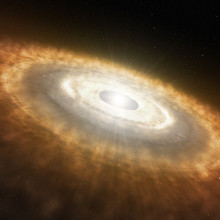
00:24 - The violent histories of hot Jupiters
The violent histories of hot Jupiters
A paper published in Nature last week has discovered that planetary systems containing so-called hot Jupiters are likely to have had violent pasts.
The evidence stems from a difference in the way that these planets orbit their parent stars. In our own solar system, the planets orbit the Sun in very similar planes, so that any three-dimensional model of the solar system looks rather like a dinner plate, with all of the planets orbiting in the surface of the plate. In addition, the Sun's own rotation axis is closely aligned with the orbits of the planets.
 This alignment is as we would expect from our understanding of how planetary systems form. We think that both stars and planets form from proto-planetary discs -- clouds of gas and dust that collapse under their own gravity, flattening into a swirling disk. The central part of such a disk forms a star, while the outer parts may form into a number of planets around it. Since both the star and the orbits of its planets derive their rotation from the same disk, we would expect them both to be aligned with the disk's original rotation axis.
This alignment is as we would expect from our understanding of how planetary systems form. We think that both stars and planets form from proto-planetary discs -- clouds of gas and dust that collapse under their own gravity, flattening into a swirling disk. The central part of such a disk forms a star, while the outer parts may form into a number of planets around it. Since both the star and the orbits of its planets derive their rotation from the same disk, we would expect them both to be aligned with the disk's original rotation axis.
However, the pattern seen in our own solar system has not been reproduced by other planetary systems that we have observed. These systems often have large Jupiter-sized planets orbiting very close to their parent stars, at a similar distance to that of Mercury from our own Sun. Moreover, the orbital planes of these so-called "hot Jupiters" are almost randomly orientated, showing little correlation with the rotation axes of their parent stars.
It is a puzzle how these systems form, and astronomers think it likely that these Jupiter-sized planets form much further out from their host stars, but later migrate inwards, perhaps as a result of violent gravitational interactions with their neighbours or with nearby stars.
Writing in Nature, Roberto Sanchiz-O'Jeda of MIT and his colleagues present the first observations of the orbits of the planets in a more normal system, as observed by the Kepler Space Telescope. They find that this system, like our own, has the planets orbiting in a common plane which is aligned with the host star's rotation axis.
The implication is that planetary systems do indeed form with their planets orbiting in a common plane, but that violent interactions can upset the orbital alignment. This confirms the theory that hot Jupiters do not form in their present locations, but migrate inward as a result of violent events in their histories.
03:56 - Do elephants purr?
Do elephants purr?
 The way elephants make the low-frequency rumbles they use to communicate over long distances has been revealed by scientists in Austria. Humans and other mammals use sound extensively; whales and elephants produce frequencies as low as 9Hz, and some species of bat are capable of ultrasound frequencies exceeding 110,000Hz.
The way elephants make the low-frequency rumbles they use to communicate over long distances has been revealed by scientists in Austria. Humans and other mammals use sound extensively; whales and elephants produce frequencies as low as 9Hz, and some species of bat are capable of ultrasound frequencies exceeding 110,000Hz.
In all of these cases, these vocalisations are produced by passing air over the vocal folds, making them vibrate. But there are two ways to produce sounds like this. One is known as myoelastic aerodynamic noise production and is the means by which we speak and sing. To make these sounds we close the vocal cords or "glottis" and apply push air from the lungs against them. At a certain pressure the vocal cords part and a rush of air ensues. This causes the pressure to drop and the vocal cords then come together again, re-starting the process and setting up vibrations that resonate in the mouth and throat.
Purring, on the other hand, which cats typically do, involves rhythmic opening and closing of the vocal cords under nervous control at the rate of about 30Hz. This creates surges of air through the alternately open and closed glottis and sounds of the same frequency.
But do elephants do this to produce the human-inaudible infrasonic noises they are known to emit? To find out, Christian Herbst and his colleagues at the University of Vienna took advantage of the natural death of an elephant at a Berlin zoo to study the the animal's larynx. The team excised the entire elephant voicebox and connected it to an artificial lung to push in air. They closed the vocal cords by bringing together the supporting cartilage structures called the arytenoids, as would occur in life, and placed sensors to record sound production and the contact between the vocal cords.
Isolating the vocal cords from their air supply like this means that purring is impossible, so any ensuing sound must be being produced by myoelastic-aerodynamic means. As they turned up the pressure to about 4 times would it takes to vibrate a human voicebox, the elephant larynx started making sounds of about 16Hz, close to the 20Hz frequency of infrasounds recorded from living elephants in the wild. High-speed photography confirmed that the vocal cords were repeatedly opening as pressure built up and then closing again at air passed through, setting up vibrations in the tissue.
Concluding their paper in Science this week, the team point out that this study is the first to directly observe the sound production mechanism of elephant infrasound vocalisations. "We have shown that low-frequency phonation can be created by flow-induced self-sustaining oscillations of the vocal folds, in accordance with the myoelastic-aerodynamic theory of voice production." But the team also caution that they cannot rule out the possibility that elephants can also purr. But there proabably aren't many brave enough to volunteer to implant the electrodes that would be required to find out...
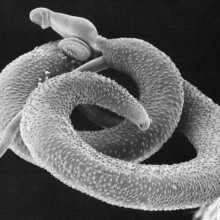
07:04 - Building an Immunity to Bilharzia
Building an Immunity to Bilharzia
Dr Kate Mitchell, Edinburgh University
Chris - Schistosomiasis is also known as bilharzia and it is a disease that's caused by worms, and they grow for part of their lives in a species of aquatic snail, and they then infect humans that are exposed to water where those snails live. More than 200 million people are infected and in the majority of cases, people carry the worms for many years and this leads to damage to organs inside the person including damage to their bladder and also to their liver. Adult humans eventually develop immunity to the infection but for some reason, children don't. Now, scientists have discovered why and this could help us to develop a new vaccine. Kate Mitchell who carried out this work while she was a PhD student at Edinburgh University is the scientist behind the breakthrough. Hello, Kate.
Kate - Hello.
Chris - So, how did you actually do this?
 Kate - We took a fresh look at several decades worth of data that's being collected by many people and looking at infection levels and antibody levels in different populations. And then we used new computer models that we've developed to investigate a number of different ideas that people have about how protective immunity develops to schistosomiasis. And so, we took a number of these different theories and ideas, and used these to construct different models and we had almost 3,000 models in total that we looked at quite systematically and then we ran millions of computer simulations to see whether the models could produce the patterns that we see in the field data.
Kate - We took a fresh look at several decades worth of data that's being collected by many people and looking at infection levels and antibody levels in different populations. And then we used new computer models that we've developed to investigate a number of different ideas that people have about how protective immunity develops to schistosomiasis. And so, we took a number of these different theories and ideas, and used these to construct different models and we had almost 3,000 models in total that we looked at quite systematically and then we ran millions of computer simulations to see whether the models could produce the patterns that we see in the field data.
Chris - What were the hypotheses that you started with? What sorts of questions or possibilities were you playing with or modelling when you started?
Kate - So, one of the main ones we're interested in was, there's a theory that it's only when the adult worms die that they release the right proteins that could stimulate an immune response. The worms live for several years inside humans so that could be delaying the exposure. So we looked at that as one of our hypotheses but we also wanted to check, well what happens if actually, those proteins are coming from other stages of their life cycle so the infectious stage, when you're initially infected or the eggs that worms lay. And we also weren't sure what the effect of the protective immune response is - is it preventing people from becoming re-infected? Is it killing the worms directly? Or is it stopping them laying the eggs? It's the eggs that cause a lot of the damage that we see. So we looked at all those different combinations. There are also different ideas about the precise nature of the immune response, how long the worms live for, that kind of thing.
Chris - Where did you get the data to then test these theories against?
Kate - So we had several large field tests that as our group at the University of Edinburgh has conducted in Zimbabwe over the last 20 years or so. Data from different populations where we had measured infection levels and antibodies in children and adults in these communities. We also used published data from Zimbabwe and other African countries going back as far as the 1960s.
Chris - So, you had all these hypotheses, you had built clever models that enable you to test all the possibilities so you'll know what the outcome should be if that possibility is right. You then compare that with the data and see if it fits the pattern you would expect if that hypothesis is true. What emerged as the thing that you think is the reason why the adults get the immunity eventually and then spit out the worms? Not really obviously, they suppress the worms. I don't want to give anyone nightmares, but children don't. What's going on?
Kate - So, we actually got a very clear answer and it related to some of these theories that I outlined earlier. The protective response, the one that's actually protecting against disease is triggered by proteins that are released when the adult worms die. And this is stimulating antibody responses. And what those antibodies are actually doing is preventing the remaining worms from laying any further eggs. And the reason why this is usually only seen in adults is just because it takes a long time to actually get enough exposure for enough worms to die and trigger enough response for it to be effective.
Chris - Because the worms themselves can suppress the immune system, they sort of evade the immune system so that the immune system can't see them. They're mostly invisible, cloaked to the immune system when they're alive and it's only when they die, that that cloaking device (for want of a better phrase) breaks down and the immune system can see the worm and make a response to it. That response is then effective at stopping other worms that are alive, making any eggs.
Kate - Partly. So, that was one hypothesis that we tested. Are the worms just suppressing this protective response? And actually, that wasn't really giving us results that were consistent with the data. So they certainly are suppressing some responses. I mean, there are all sorts of immune responses going on. There are a lot of inflammatory responses to the eggs, so we suspect the suppression is of an early response that would damage the worms. But the response that we're detecting here with these models is a protective response. It's a different response that is just taking an awful lot of time to build enough exposure.
Chris - If it takes a long time, what is the prospect then of being able to make some kind of vaccine that will make a child make that response? So that if they are exposed to the snails in the water, and the worm is trying to infect them, it wouldn't be able to?
Kate - It's probably part of a question of quantity and identifying the correct proteins that you need to put into your vaccine to create the right response.
Chris - But this would suggest that it is possible. So, if we can simulate what happens to an adult given enough time in a child, we would be able to protect the child potentially against bilharzia.
Kate - Yes, that would be the aim.
Chris - Let's hope so. Thank you very much. That's Kate Mitchell. She's now working at London School of Hygiene and Tropical Medicine. She was talking there about the work she did towards her PhD when she was at Edinburgh University.

12:32 - Black holes, as revealed by X-rays
Black holes, as revealed by X-rays
This week, the journal Science have produced a special issue dedicated to the subject of black hole research, and Rob Fender of the University of Southampton reviewed what we know about the X-ray emission of black holes.
Black holes are the collapsed end state in the lives of stars more massive than a few times the mass of the Sun. When these stars run out of fuel, no force can overcome the gravitational self-attraction of their cores, which consequently collapse down to an infinitely small point in an event called a Type II supernova explosion. The result is a black hole with a mass of a few times that of the Sun.
It is estimated that there are likely to be at least 100 million such black holes in our galaxy, based on the number of massive stars that we see today, and their estimated lifetime of a few million years. Yet although this makes them quite common objects, they are very difficult to observe as not even light can travel fast enough to escape from their surfaces.
The tell-tale sign of a black hole is X-ray emission, produced whenever gas falls in towards the event horizon. In the process of spiralling in towards its ultimate fate, this gas reaches incredibly high temperatures and densities as it is compressed into an ever smaller space. At temperatures of hundreds of millions of degrees, it doesn't just glow red hot, it glows X-ray hot. The energy required to heat gas to these temperatures is so great that almost all processes other than the accretion of material onto a black hole can be ruled out in such objects.
However, this X-ray emission is only produced if the black hole happens to have a source of gas falling onto it. Most of the Milky Way galaxy is a deep vacuum, with stars no closer than a few lightyears apart. So it is only those black holes that have close companion stars that can accrete gas at a significant rate, by gradually stripping the outer layers of gas from their companions.
Moreover, the accretion process is so violent that it is rarely sustained. Instead, black holes undergo fits of accretion, accompanied by explosive outbursts, which then prevent any further accretion from taking place for many months, or perhaps even many centuries. This means that in the past few decades of black hole research, we have only seen the tip of the iceburg of the Milky Way's black hole population.
Significant questions remain. We know that there is a supermassive black hole at the centre of the Milky Way which has a mass of several million times the mass of the Sun, and it appears that most other galaxies also have similarly sized black holes at their centres. How do these black holes acquire so much mass? They must have found an acretion mode which is much faster than simply munching on the outer envelopes of close companion stars.
Another interesting problem is that some galaxies, known as active galaxies, have intensely bright nuclei, understood to be powered by a flow of gas onto the central black hole. Others, like our own galaxy, appear not to have any flow of gas onto their central black holes. Why is this so? Do supermassive black holes have episodes of accretion similar to their stellar mass counterparts? It appears likely that they do, on a vastly enlarged scale.
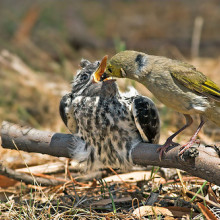
16:41 - Alzheimer's Protein Relieves MS Paralysis
Alzheimer's Protein Relieves MS Paralysis
Lawrence Steinman, Stanford University; Damian Dowling, Monash University; Rose Thorogood, University of Cambridge; Aaron Johnson, University of Pennsylvania
Alzheimer's protein relieves MS paralysis
A protein found in the brain of Alzheimer's sufferers has been shown to relieve paralysis in mice with the autoimmune disease multiple sclerosis, or MS.
MS is caused by the immune system attacking the protective myelin sheath around nerve fibres in the central nervous system. One symptom is inflammation of the brain, which can result in paralysis.
Lawrence Steinman of Stanford University reports in Science Translational Medicine. "We found in the multiple sclerosis brain a molecule called beta amyloid. This molecule has a famous and villainous role in Alzheimer's disease where most scientists think it's the culprit at the root of the Alzheimer's dementia.
So we attempted to find out what this molecule might be doing by going backward and seeing, "Okay, it's in the MS brain. What it might to do in a mouse model of multiple sclerosis? To our great surprise, the molecule provided great benefit. Animals that were paralysed became better and the inflammation melted away in their brain."
Why women live longer than men
Females outlive males not only in humans, but in many other species as well. According to research in the American Naturalist, this discrepancy could arise from the mechanism of inheritance of mitochondrial DNA.
Damian Dowling and his research team at Monash University have identified mutations in fruitfly mitochondrial DNA that are harmful to males but not females. "What we did was uncover numerous mutations within the genes of mitochondria that cause males to age faster and live shorter lives than females.
The existence of these mutations can be entirely attributed to a quirk in the way that mitochondrial genes are passed down from parents to children. While children receive copies of most of their genes from both their mothers and their fathers. They only receive mitochondrial genes from their mothers.
"The implication is profound. It means that evolution's quality control process only screens the quality of mitochondrial genes when they're inside mothers. So, if a mitochondrial mutation occurs that harms fathers, but has no effect on mothers, this mutation will slip through the gates of natural selection unnoticed."
A new disguise for cuckoos
Cuckoos famously parasitise other bird species by laying eggs in their nests and allowing the host species to raise them. Not only that, but cuckoo chicks have evolved to push out the host's own eggs in order to gain their foster parents' full attention.
Cuckoos also mimic the appearance of predatory grey sparrowhawks, intimidating the hosts out of attacking the cuckoo.
However, one host species, the reed warbler, can learn to recognise disguised cuckoos for what they really are, and will mob them on sight.
Research published in Science by Rose Thorogood of the University of Cambridge shows that the cuckoos are now evolving a counter-attack. A new disguise of a red-brown plumage helps part of the cuckoo population avoid reed warbler mobbings.
"So we know that cuckoos are in a race with their hosts. We know from previous work that reed warblers have learned to defend themselves against cuckoos by watching their neighbours to tell when a grey cuckoo is a grey cuckoo and not the dangerous sparrow hawk. But we also know that cuckoos come in different colours, so we wanted to know if this was yet another cuckoo trick to beat these host defences. So, the most exciting thing of what we found is that the reed warblers actually only learn about the cuckoo morph that they see their neighbours mob. And why this is exciting is it means that they're sharing information amongst each other to try and beat their enemies, but actually, in the process of sharing this specific information, it's in turn selecting for this new cuckoo disguise."
Rex the robot gets a tail
And finally, Aaron Johnson at the University of Pennsylvania has been exploiting a novel way to make robots better at travelling over rough terrain: by adding a tail.
Research at the University of California, Berkeley has helped understand how animals use their tails for enhanced balance and agility.
Johnson has applied these findings to create a tail for a Rex, a six-legged robot who was perfectly capable on flat ground, but needed a little extra help on rougher ground...
"This has allowed Rex to be able to right itself when it's falling. Two examples - one is if you're falling nose down, you're going to hit your face on the ground and maybe break a leg, but instead it kicks the tail and is able to land on all six legs safely. And then the other case maybe starting out level because you're running off of a cliff, but as you run over the edge, you're going to start to pitch downwards. And so, it's able to detect that, kick its tail up and still land on its feet."
And complete with its new tail, Rex is now capable of safely falling nose-first from heights of 2.7 times its own body length.
Related Content
- Previous Mars Curiosity Extra
- Next Curious about Mars...










Comments
Add a comment